Consumer Behavior and Decision Making in the Tourism Sector: Report
VerifiedAdded on 2023/01/11
|15
|4500
|84
Report
AI Summary
This report delves into the multifaceted realm of tourism consumer behavior, utilizing Trailfinders as a case study to examine the factors influencing consumer attitudes and purchasing decisions. It investigates the impact of cultural, social, personal, and psychological elements on tourist behavior and analyzes how digital technology reshapes consumer trends, including expectations and access to information. The report meticulously explores the stages of the consumer decision-making journey, from need recognition to post-purchase evaluation, and underscores the significance of mapping purchase paths for effective marketing. It also contrasts decision-making processes in B2B and B2C contexts within the hospitality sector, evaluates research methods for understanding consumer choices, and assesses how marketers can influence each stage of the decision-making process through applied methods and models. The report concludes with an evaluation of marketing strategies and their impact on consumer behavior in the tourism industry, providing valuable insights for marketers and tourism professionals.
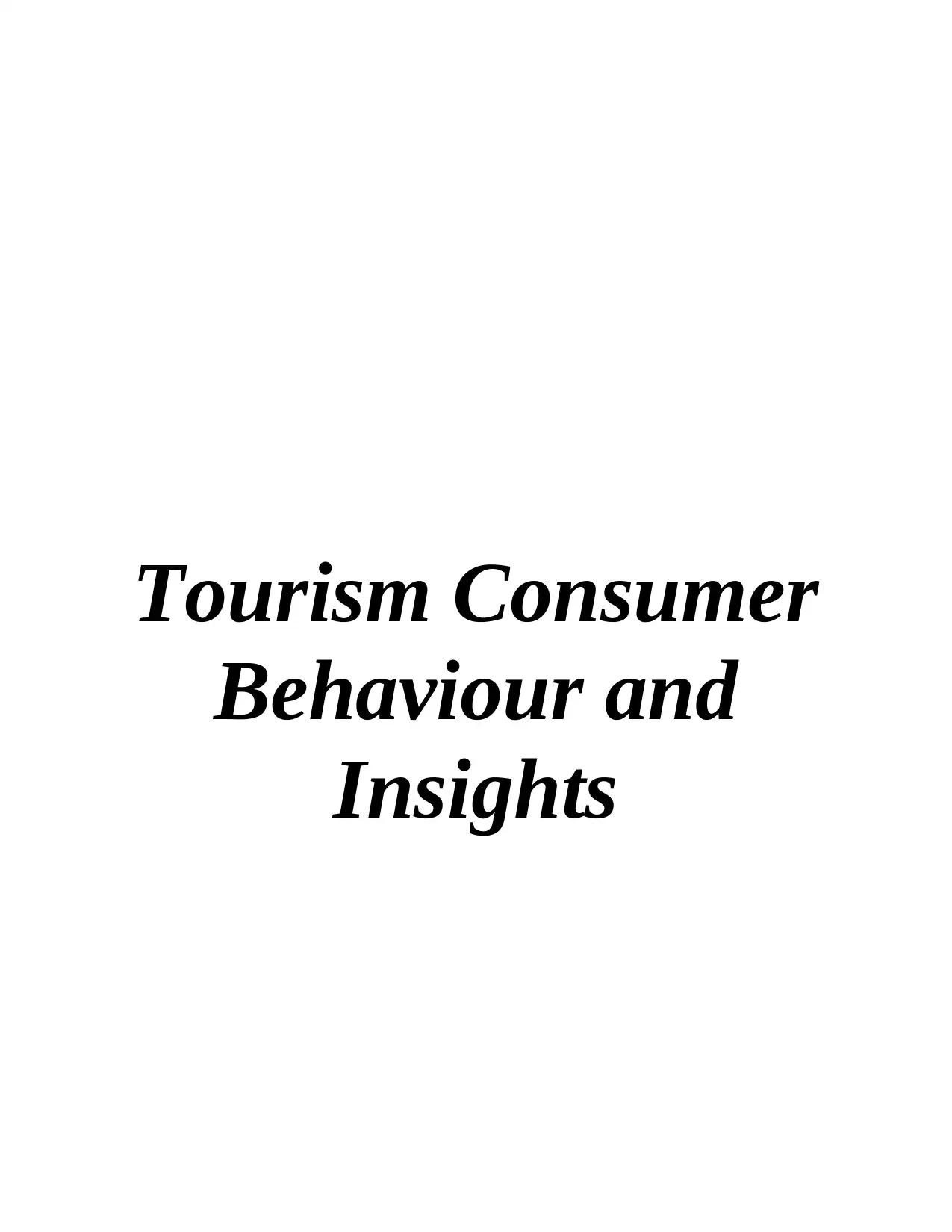
Tourism Consumer
Behaviour and
Insights
Behaviour and
Insights
Paraphrase This Document
Need a fresh take? Get an instant paraphrase of this document with our AI Paraphraser
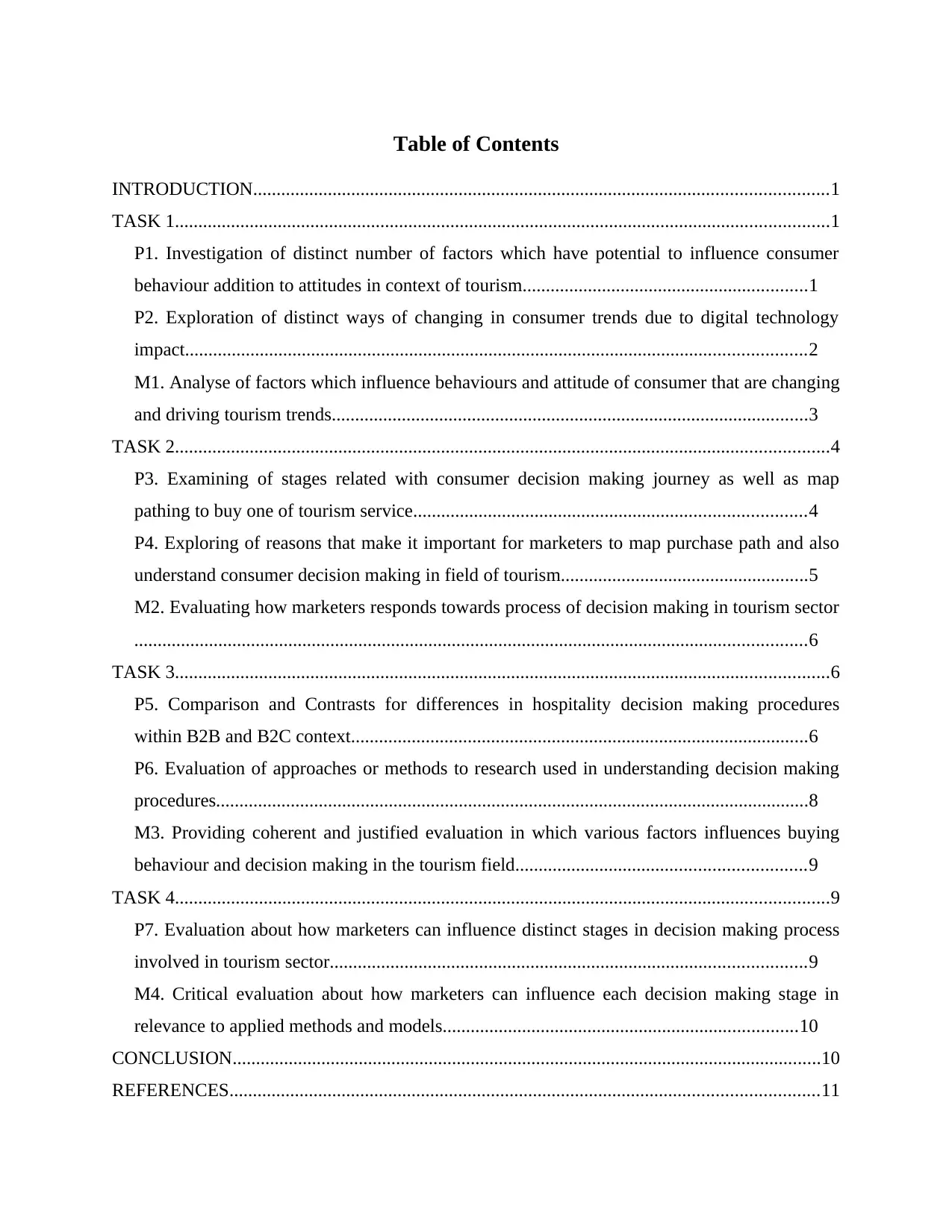
Table of Contents
INTRODUCTION...........................................................................................................................1
TASK 1............................................................................................................................................1
P1. Investigation of distinct number of factors which have potential to influence consumer
behaviour addition to attitudes in context of tourism.............................................................1
P2. Exploration of distinct ways of changing in consumer trends due to digital technology
impact.....................................................................................................................................2
M1. Analyse of factors which influence behaviours and attitude of consumer that are changing
and driving tourism trends......................................................................................................3
TASK 2............................................................................................................................................4
P3. Examining of stages related with consumer decision making journey as well as map
pathing to buy one of tourism service....................................................................................4
P4. Exploring of reasons that make it important for marketers to map purchase path and also
understand consumer decision making in field of tourism.....................................................5
M2. Evaluating how marketers responds towards process of decision making in tourism sector
................................................................................................................................................6
TASK 3............................................................................................................................................6
P5. Comparison and Contrasts for differences in hospitality decision making procedures
within B2B and B2C context..................................................................................................6
P6. Evaluation of approaches or methods to research used in understanding decision making
procedures...............................................................................................................................8
M3. Providing coherent and justified evaluation in which various factors influences buying
behaviour and decision making in the tourism field..............................................................9
TASK 4............................................................................................................................................9
P7. Evaluation about how marketers can influence distinct stages in decision making process
involved in tourism sector......................................................................................................9
M4. Critical evaluation about how marketers can influence each decision making stage in
relevance to applied methods and models............................................................................10
CONCLUSION..............................................................................................................................10
REFERENCES..............................................................................................................................11
INTRODUCTION...........................................................................................................................1
TASK 1............................................................................................................................................1
P1. Investigation of distinct number of factors which have potential to influence consumer
behaviour addition to attitudes in context of tourism.............................................................1
P2. Exploration of distinct ways of changing in consumer trends due to digital technology
impact.....................................................................................................................................2
M1. Analyse of factors which influence behaviours and attitude of consumer that are changing
and driving tourism trends......................................................................................................3
TASK 2............................................................................................................................................4
P3. Examining of stages related with consumer decision making journey as well as map
pathing to buy one of tourism service....................................................................................4
P4. Exploring of reasons that make it important for marketers to map purchase path and also
understand consumer decision making in field of tourism.....................................................5
M2. Evaluating how marketers responds towards process of decision making in tourism sector
................................................................................................................................................6
TASK 3............................................................................................................................................6
P5. Comparison and Contrasts for differences in hospitality decision making procedures
within B2B and B2C context..................................................................................................6
P6. Evaluation of approaches or methods to research used in understanding decision making
procedures...............................................................................................................................8
M3. Providing coherent and justified evaluation in which various factors influences buying
behaviour and decision making in the tourism field..............................................................9
TASK 4............................................................................................................................................9
P7. Evaluation about how marketers can influence distinct stages in decision making process
involved in tourism sector......................................................................................................9
M4. Critical evaluation about how marketers can influence each decision making stage in
relevance to applied methods and models............................................................................10
CONCLUSION..............................................................................................................................10
REFERENCES..............................................................................................................................11

⊘ This is a preview!⊘
Do you want full access?
Subscribe today to unlock all pages.

Trusted by 1+ million students worldwide
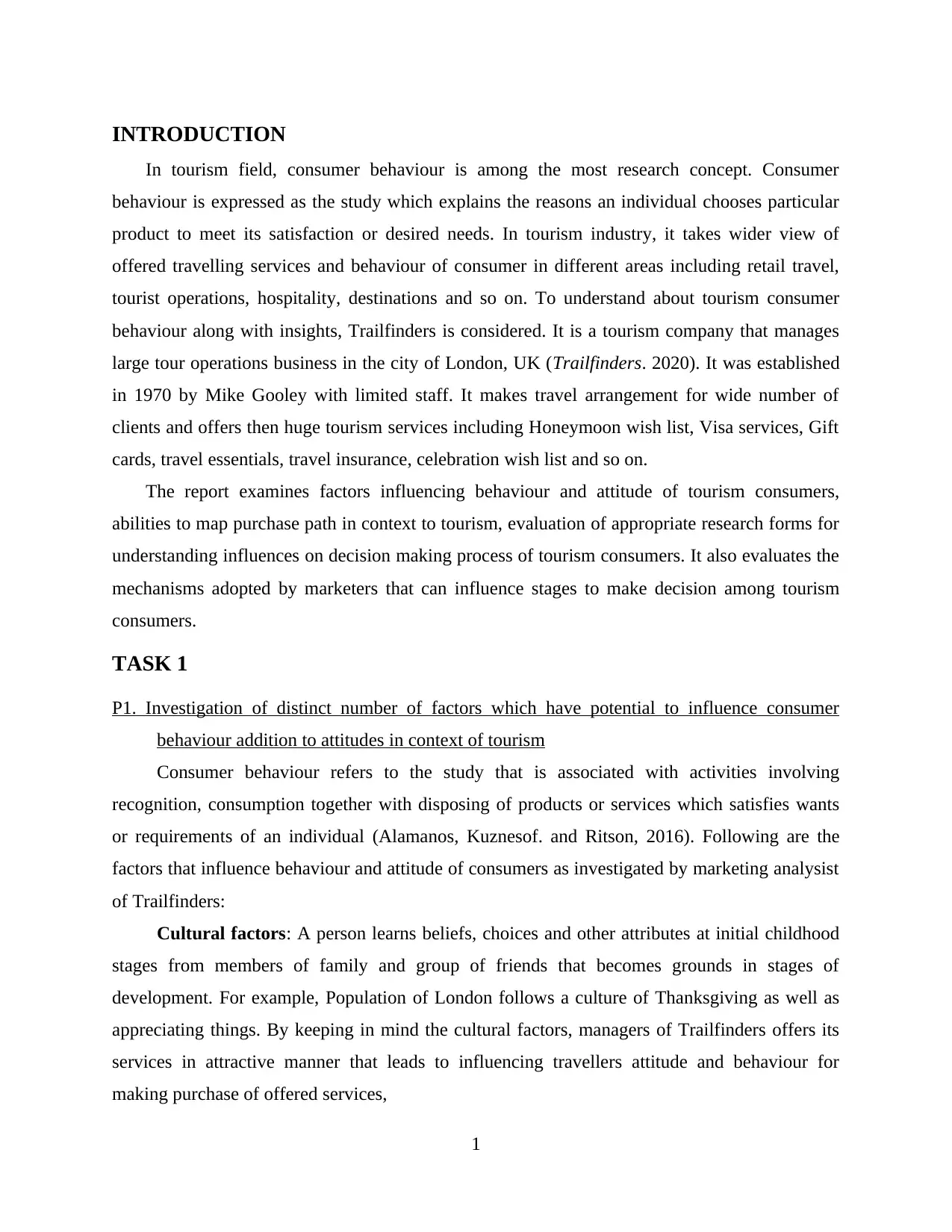
INTRODUCTION
In tourism field, consumer behaviour is among the most research concept. Consumer
behaviour is expressed as the study which explains the reasons an individual chooses particular
product to meet its satisfaction or desired needs. In tourism industry, it takes wider view of
offered travelling services and behaviour of consumer in different areas including retail travel,
tourist operations, hospitality, destinations and so on. To understand about tourism consumer
behaviour along with insights, Trailfinders is considered. It is a tourism company that manages
large tour operations business in the city of London, UK (Trailfinders. 2020). It was established
in 1970 by Mike Gooley with limited staff. It makes travel arrangement for wide number of
clients and offers then huge tourism services including Honeymoon wish list, Visa services, Gift
cards, travel essentials, travel insurance, celebration wish list and so on.
The report examines factors influencing behaviour and attitude of tourism consumers,
abilities to map purchase path in context to tourism, evaluation of appropriate research forms for
understanding influences on decision making process of tourism consumers. It also evaluates the
mechanisms adopted by marketers that can influence stages to make decision among tourism
consumers.
TASK 1
P1. Investigation of distinct number of factors which have potential to influence consumer
behaviour addition to attitudes in context of tourism
Consumer behaviour refers to the study that is associated with activities involving
recognition, consumption together with disposing of products or services which satisfies wants
or requirements of an individual (Alamanos, Kuznesof. and Ritson, 2016). Following are the
factors that influence behaviour and attitude of consumers as investigated by marketing analysist
of Trailfinders:
Cultural factors: A person learns beliefs, choices and other attributes at initial childhood
stages from members of family and group of friends that becomes grounds in stages of
development. For example, Population of London follows a culture of Thanksgiving as well as
appreciating things. By keeping in mind the cultural factors, managers of Trailfinders offers its
services in attractive manner that leads to influencing travellers attitude and behaviour for
making purchase of offered services,
1
In tourism field, consumer behaviour is among the most research concept. Consumer
behaviour is expressed as the study which explains the reasons an individual chooses particular
product to meet its satisfaction or desired needs. In tourism industry, it takes wider view of
offered travelling services and behaviour of consumer in different areas including retail travel,
tourist operations, hospitality, destinations and so on. To understand about tourism consumer
behaviour along with insights, Trailfinders is considered. It is a tourism company that manages
large tour operations business in the city of London, UK (Trailfinders. 2020). It was established
in 1970 by Mike Gooley with limited staff. It makes travel arrangement for wide number of
clients and offers then huge tourism services including Honeymoon wish list, Visa services, Gift
cards, travel essentials, travel insurance, celebration wish list and so on.
The report examines factors influencing behaviour and attitude of tourism consumers,
abilities to map purchase path in context to tourism, evaluation of appropriate research forms for
understanding influences on decision making process of tourism consumers. It also evaluates the
mechanisms adopted by marketers that can influence stages to make decision among tourism
consumers.
TASK 1
P1. Investigation of distinct number of factors which have potential to influence consumer
behaviour addition to attitudes in context of tourism
Consumer behaviour refers to the study that is associated with activities involving
recognition, consumption together with disposing of products or services which satisfies wants
or requirements of an individual (Alamanos, Kuznesof. and Ritson, 2016). Following are the
factors that influence behaviour and attitude of consumers as investigated by marketing analysist
of Trailfinders:
Cultural factors: A person learns beliefs, choices and other attributes at initial childhood
stages from members of family and group of friends that becomes grounds in stages of
development. For example, Population of London follows a culture of Thanksgiving as well as
appreciating things. By keeping in mind the cultural factors, managers of Trailfinders offers its
services in attractive manner that leads to influencing travellers attitude and behaviour for
making purchase of offered services,
1
Paraphrase This Document
Need a fresh take? Get an instant paraphrase of this document with our AI Paraphraser
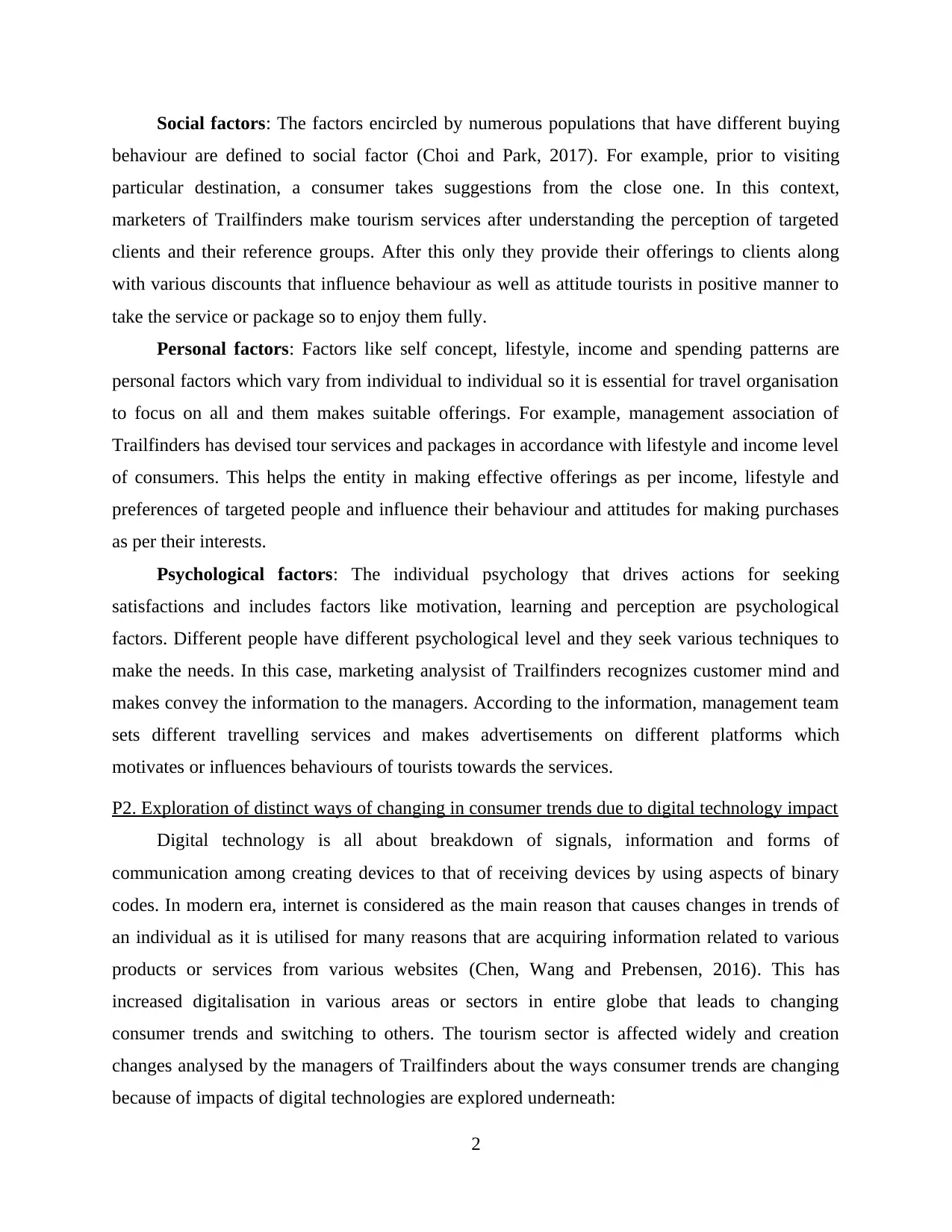
Social factors: The factors encircled by numerous populations that have different buying
behaviour are defined to social factor (Choi and Park, 2017). For example, prior to visiting
particular destination, a consumer takes suggestions from the close one. In this context,
marketers of Trailfinders make tourism services after understanding the perception of targeted
clients and their reference groups. After this only they provide their offerings to clients along
with various discounts that influence behaviour as well as attitude tourists in positive manner to
take the service or package so to enjoy them fully.
Personal factors: Factors like self concept, lifestyle, income and spending patterns are
personal factors which vary from individual to individual so it is essential for travel organisation
to focus on all and them makes suitable offerings. For example, management association of
Trailfinders has devised tour services and packages in accordance with lifestyle and income level
of consumers. This helps the entity in making effective offerings as per income, lifestyle and
preferences of targeted people and influence their behaviour and attitudes for making purchases
as per their interests.
Psychological factors: The individual psychology that drives actions for seeking
satisfactions and includes factors like motivation, learning and perception are psychological
factors. Different people have different psychological level and they seek various techniques to
make the needs. In this case, marketing analysist of Trailfinders recognizes customer mind and
makes convey the information to the managers. According to the information, management team
sets different travelling services and makes advertisements on different platforms which
motivates or influences behaviours of tourists towards the services.
P2. Exploration of distinct ways of changing in consumer trends due to digital technology impact
Digital technology is all about breakdown of signals, information and forms of
communication among creating devices to that of receiving devices by using aspects of binary
codes. In modern era, internet is considered as the main reason that causes changes in trends of
an individual as it is utilised for many reasons that are acquiring information related to various
products or services from various websites (Chen, Wang and Prebensen, 2016). This has
increased digitalisation in various areas or sectors in entire globe that leads to changing
consumer trends and switching to others. The tourism sector is affected widely and creation
changes analysed by the managers of Trailfinders about the ways consumer trends are changing
because of impacts of digital technologies are explored underneath:
2
behaviour are defined to social factor (Choi and Park, 2017). For example, prior to visiting
particular destination, a consumer takes suggestions from the close one. In this context,
marketers of Trailfinders make tourism services after understanding the perception of targeted
clients and their reference groups. After this only they provide their offerings to clients along
with various discounts that influence behaviour as well as attitude tourists in positive manner to
take the service or package so to enjoy them fully.
Personal factors: Factors like self concept, lifestyle, income and spending patterns are
personal factors which vary from individual to individual so it is essential for travel organisation
to focus on all and them makes suitable offerings. For example, management association of
Trailfinders has devised tour services and packages in accordance with lifestyle and income level
of consumers. This helps the entity in making effective offerings as per income, lifestyle and
preferences of targeted people and influence their behaviour and attitudes for making purchases
as per their interests.
Psychological factors: The individual psychology that drives actions for seeking
satisfactions and includes factors like motivation, learning and perception are psychological
factors. Different people have different psychological level and they seek various techniques to
make the needs. In this case, marketing analysist of Trailfinders recognizes customer mind and
makes convey the information to the managers. According to the information, management team
sets different travelling services and makes advertisements on different platforms which
motivates or influences behaviours of tourists towards the services.
P2. Exploration of distinct ways of changing in consumer trends due to digital technology impact
Digital technology is all about breakdown of signals, information and forms of
communication among creating devices to that of receiving devices by using aspects of binary
codes. In modern era, internet is considered as the main reason that causes changes in trends of
an individual as it is utilised for many reasons that are acquiring information related to various
products or services from various websites (Chen, Wang and Prebensen, 2016). This has
increased digitalisation in various areas or sectors in entire globe that leads to changing
consumer trends and switching to others. The tourism sector is affected widely and creation
changes analysed by the managers of Trailfinders about the ways consumer trends are changing
because of impacts of digital technologies are explored underneath:
2
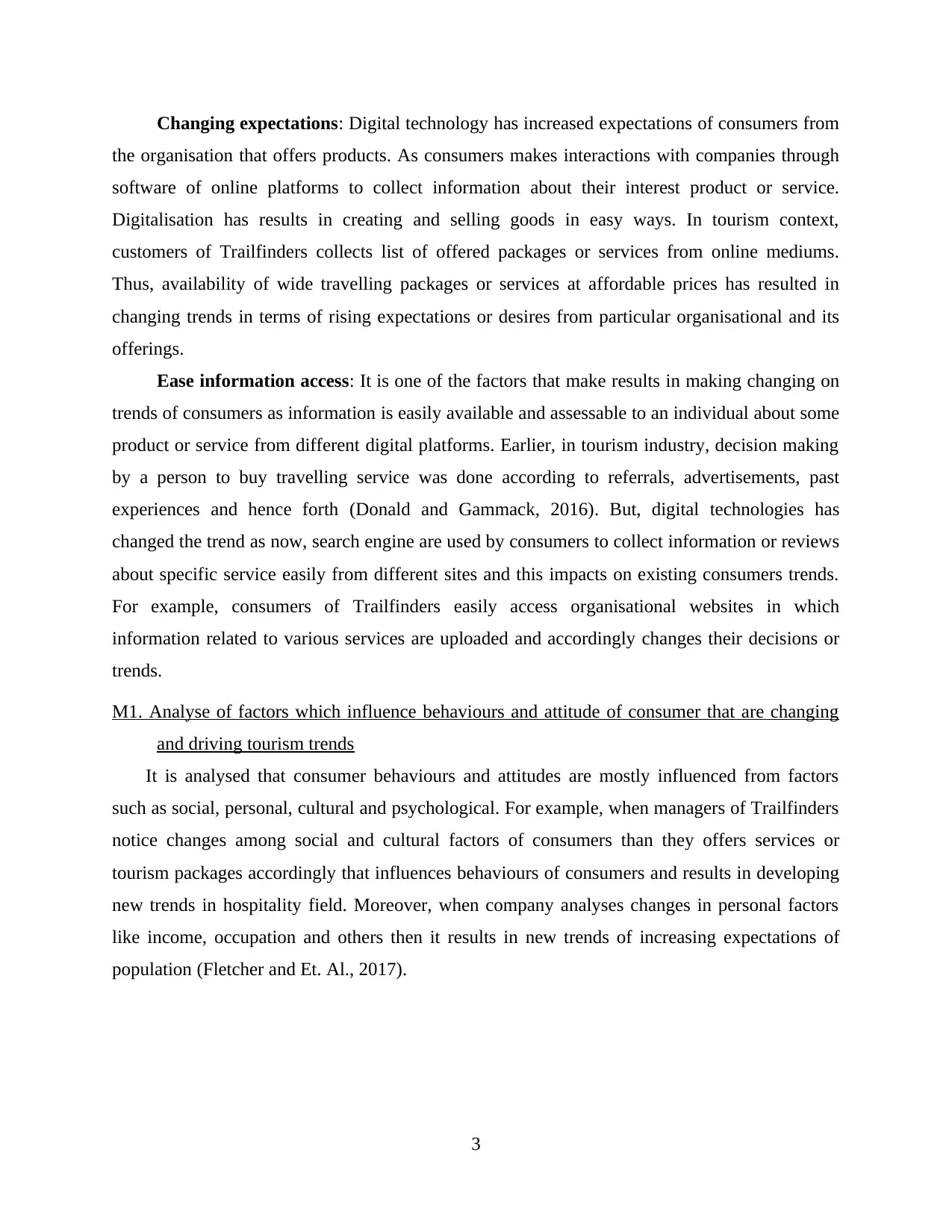
Changing expectations: Digital technology has increased expectations of consumers from
the organisation that offers products. As consumers makes interactions with companies through
software of online platforms to collect information about their interest product or service.
Digitalisation has results in creating and selling goods in easy ways. In tourism context,
customers of Trailfinders collects list of offered packages or services from online mediums.
Thus, availability of wide travelling packages or services at affordable prices has resulted in
changing trends in terms of rising expectations or desires from particular organisational and its
offerings.
Ease information access: It is one of the factors that make results in making changing on
trends of consumers as information is easily available and assessable to an individual about some
product or service from different digital platforms. Earlier, in tourism industry, decision making
by a person to buy travelling service was done according to referrals, advertisements, past
experiences and hence forth (Donald and Gammack, 2016). But, digital technologies has
changed the trend as now, search engine are used by consumers to collect information or reviews
about specific service easily from different sites and this impacts on existing consumers trends.
For example, consumers of Trailfinders easily access organisational websites in which
information related to various services are uploaded and accordingly changes their decisions or
trends.
M1. Analyse of factors which influence behaviours and attitude of consumer that are changing
and driving tourism trends
It is analysed that consumer behaviours and attitudes are mostly influenced from factors
such as social, personal, cultural and psychological. For example, when managers of Trailfinders
notice changes among social and cultural factors of consumers than they offers services or
tourism packages accordingly that influences behaviours of consumers and results in developing
new trends in hospitality field. Moreover, when company analyses changes in personal factors
like income, occupation and others then it results in new trends of increasing expectations of
population (Fletcher and Et. Al., 2017).
3
the organisation that offers products. As consumers makes interactions with companies through
software of online platforms to collect information about their interest product or service.
Digitalisation has results in creating and selling goods in easy ways. In tourism context,
customers of Trailfinders collects list of offered packages or services from online mediums.
Thus, availability of wide travelling packages or services at affordable prices has resulted in
changing trends in terms of rising expectations or desires from particular organisational and its
offerings.
Ease information access: It is one of the factors that make results in making changing on
trends of consumers as information is easily available and assessable to an individual about some
product or service from different digital platforms. Earlier, in tourism industry, decision making
by a person to buy travelling service was done according to referrals, advertisements, past
experiences and hence forth (Donald and Gammack, 2016). But, digital technologies has
changed the trend as now, search engine are used by consumers to collect information or reviews
about specific service easily from different sites and this impacts on existing consumers trends.
For example, consumers of Trailfinders easily access organisational websites in which
information related to various services are uploaded and accordingly changes their decisions or
trends.
M1. Analyse of factors which influence behaviours and attitude of consumer that are changing
and driving tourism trends
It is analysed that consumer behaviours and attitudes are mostly influenced from factors
such as social, personal, cultural and psychological. For example, when managers of Trailfinders
notice changes among social and cultural factors of consumers than they offers services or
tourism packages accordingly that influences behaviours of consumers and results in developing
new trends in hospitality field. Moreover, when company analyses changes in personal factors
like income, occupation and others then it results in new trends of increasing expectations of
population (Fletcher and Et. Al., 2017).
3
⊘ This is a preview!⊘
Do you want full access?
Subscribe today to unlock all pages.

Trusted by 1+ million students worldwide
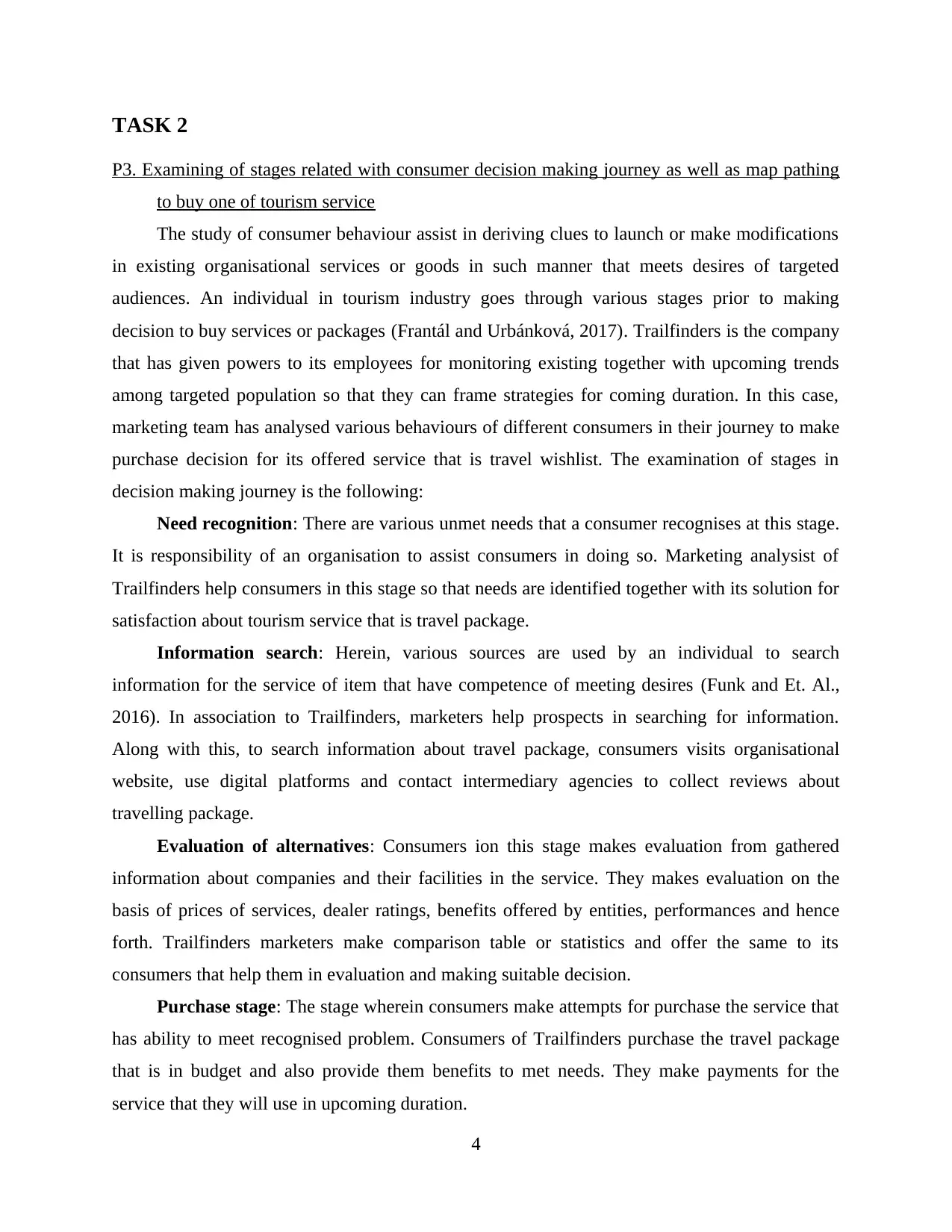
TASK 2
P3. Examining of stages related with consumer decision making journey as well as map pathing
to buy one of tourism service
The study of consumer behaviour assist in deriving clues to launch or make modifications
in existing organisational services or goods in such manner that meets desires of targeted
audiences. An individual in tourism industry goes through various stages prior to making
decision to buy services or packages (Frantál and Urbánková, 2017). Trailfinders is the company
that has given powers to its employees for monitoring existing together with upcoming trends
among targeted population so that they can frame strategies for coming duration. In this case,
marketing team has analysed various behaviours of different consumers in their journey to make
purchase decision for its offered service that is travel wishlist. The examination of stages in
decision making journey is the following:
Need recognition: There are various unmet needs that a consumer recognises at this stage.
It is responsibility of an organisation to assist consumers in doing so. Marketing analysist of
Trailfinders help consumers in this stage so that needs are identified together with its solution for
satisfaction about tourism service that is travel package.
Information search: Herein, various sources are used by an individual to search
information for the service of item that have competence of meeting desires (Funk and Et. Al.,
2016). In association to Trailfinders, marketers help prospects in searching for information.
Along with this, to search information about travel package, consumers visits organisational
website, use digital platforms and contact intermediary agencies to collect reviews about
travelling package.
Evaluation of alternatives: Consumers ion this stage makes evaluation from gathered
information about companies and their facilities in the service. They makes evaluation on the
basis of prices of services, dealer ratings, benefits offered by entities, performances and hence
forth. Trailfinders marketers make comparison table or statistics and offer the same to its
consumers that help them in evaluation and making suitable decision.
Purchase stage: The stage wherein consumers make attempts for purchase the service that
has ability to meet recognised problem. Consumers of Trailfinders purchase the travel package
that is in budget and also provide them benefits to met needs. They make payments for the
service that they will use in upcoming duration.
4
P3. Examining of stages related with consumer decision making journey as well as map pathing
to buy one of tourism service
The study of consumer behaviour assist in deriving clues to launch or make modifications
in existing organisational services or goods in such manner that meets desires of targeted
audiences. An individual in tourism industry goes through various stages prior to making
decision to buy services or packages (Frantál and Urbánková, 2017). Trailfinders is the company
that has given powers to its employees for monitoring existing together with upcoming trends
among targeted population so that they can frame strategies for coming duration. In this case,
marketing team has analysed various behaviours of different consumers in their journey to make
purchase decision for its offered service that is travel wishlist. The examination of stages in
decision making journey is the following:
Need recognition: There are various unmet needs that a consumer recognises at this stage.
It is responsibility of an organisation to assist consumers in doing so. Marketing analysist of
Trailfinders help consumers in this stage so that needs are identified together with its solution for
satisfaction about tourism service that is travel package.
Information search: Herein, various sources are used by an individual to search
information for the service of item that have competence of meeting desires (Funk and Et. Al.,
2016). In association to Trailfinders, marketers help prospects in searching for information.
Along with this, to search information about travel package, consumers visits organisational
website, use digital platforms and contact intermediary agencies to collect reviews about
travelling package.
Evaluation of alternatives: Consumers ion this stage makes evaluation from gathered
information about companies and their facilities in the service. They makes evaluation on the
basis of prices of services, dealer ratings, benefits offered by entities, performances and hence
forth. Trailfinders marketers make comparison table or statistics and offer the same to its
consumers that help them in evaluation and making suitable decision.
Purchase stage: The stage wherein consumers make attempts for purchase the service that
has ability to meet recognised problem. Consumers of Trailfinders purchase the travel package
that is in budget and also provide them benefits to met needs. They make payments for the
service that they will use in upcoming duration.
4
Paraphrase This Document
Need a fresh take? Get an instant paraphrase of this document with our AI Paraphraser
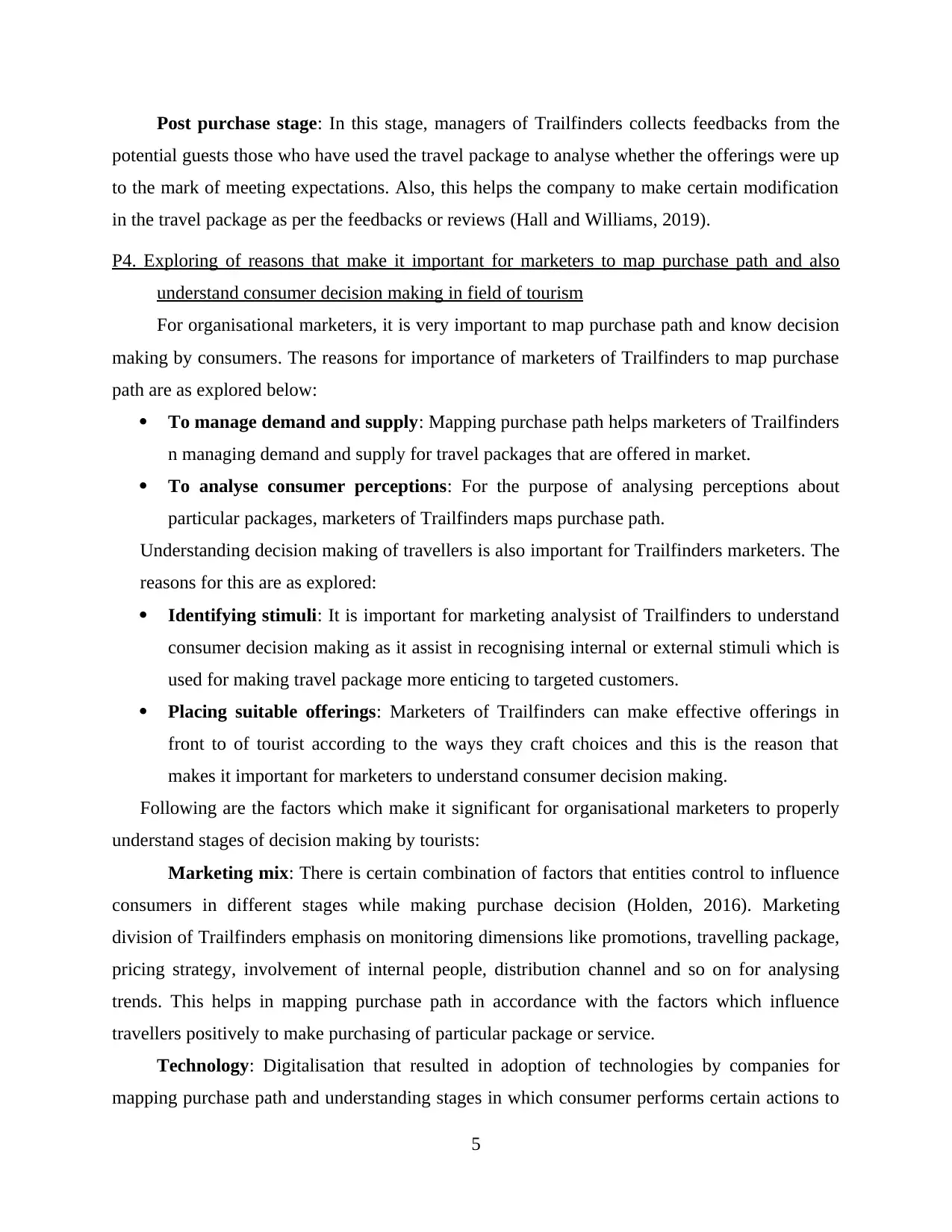
Post purchase stage: In this stage, managers of Trailfinders collects feedbacks from the
potential guests those who have used the travel package to analyse whether the offerings were up
to the mark of meeting expectations. Also, this helps the company to make certain modification
in the travel package as per the feedbacks or reviews (Hall and Williams, 2019).
P4. Exploring of reasons that make it important for marketers to map purchase path and also
understand consumer decision making in field of tourism
For organisational marketers, it is very important to map purchase path and know decision
making by consumers. The reasons for importance of marketers of Trailfinders to map purchase
path are as explored below:
To manage demand and supply: Mapping purchase path helps marketers of Trailfinders
n managing demand and supply for travel packages that are offered in market.
To analyse consumer perceptions: For the purpose of analysing perceptions about
particular packages, marketers of Trailfinders maps purchase path.
Understanding decision making of travellers is also important for Trailfinders marketers. The
reasons for this are as explored:
Identifying stimuli: It is important for marketing analysist of Trailfinders to understand
consumer decision making as it assist in recognising internal or external stimuli which is
used for making travel package more enticing to targeted customers.
Placing suitable offerings: Marketers of Trailfinders can make effective offerings in
front to of tourist according to the ways they craft choices and this is the reason that
makes it important for marketers to understand consumer decision making.
Following are the factors which make it significant for organisational marketers to properly
understand stages of decision making by tourists:
Marketing mix: There is certain combination of factors that entities control to influence
consumers in different stages while making purchase decision (Holden, 2016). Marketing
division of Trailfinders emphasis on monitoring dimensions like promotions, travelling package,
pricing strategy, involvement of internal people, distribution channel and so on for analysing
trends. This helps in mapping purchase path in accordance with the factors which influence
travellers positively to make purchasing of particular package or service.
Technology: Digitalisation that resulted in adoption of technologies by companies for
mapping purchase path and understanding stages in which consumer performs certain actions to
5
potential guests those who have used the travel package to analyse whether the offerings were up
to the mark of meeting expectations. Also, this helps the company to make certain modification
in the travel package as per the feedbacks or reviews (Hall and Williams, 2019).
P4. Exploring of reasons that make it important for marketers to map purchase path and also
understand consumer decision making in field of tourism
For organisational marketers, it is very important to map purchase path and know decision
making by consumers. The reasons for importance of marketers of Trailfinders to map purchase
path are as explored below:
To manage demand and supply: Mapping purchase path helps marketers of Trailfinders
n managing demand and supply for travel packages that are offered in market.
To analyse consumer perceptions: For the purpose of analysing perceptions about
particular packages, marketers of Trailfinders maps purchase path.
Understanding decision making of travellers is also important for Trailfinders marketers. The
reasons for this are as explored:
Identifying stimuli: It is important for marketing analysist of Trailfinders to understand
consumer decision making as it assist in recognising internal or external stimuli which is
used for making travel package more enticing to targeted customers.
Placing suitable offerings: Marketers of Trailfinders can make effective offerings in
front to of tourist according to the ways they craft choices and this is the reason that
makes it important for marketers to understand consumer decision making.
Following are the factors which make it significant for organisational marketers to properly
understand stages of decision making by tourists:
Marketing mix: There is certain combination of factors that entities control to influence
consumers in different stages while making purchase decision (Holden, 2016). Marketing
division of Trailfinders emphasis on monitoring dimensions like promotions, travelling package,
pricing strategy, involvement of internal people, distribution channel and so on for analysing
trends. This helps in mapping purchase path in accordance with the factors which influence
travellers positively to make purchasing of particular package or service.
Technology: Digitalisation that resulted in adoption of technologies by companies for
mapping purchase path and understanding stages in which consumer performs certain actions to
5
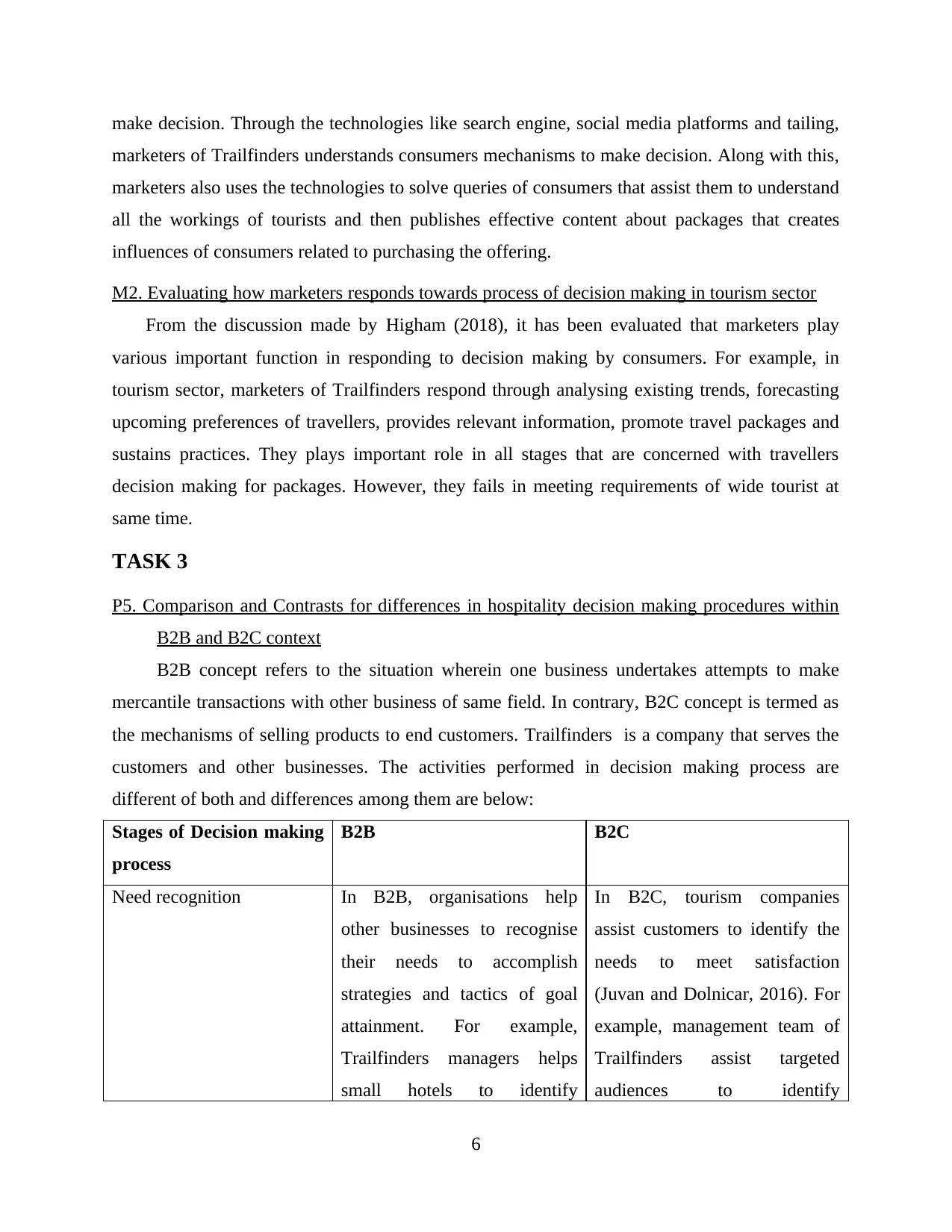
make decision. Through the technologies like search engine, social media platforms and tailing,
marketers of Trailfinders understands consumers mechanisms to make decision. Along with this,
marketers also uses the technologies to solve queries of consumers that assist them to understand
all the workings of tourists and then publishes effective content about packages that creates
influences of consumers related to purchasing the offering.
M2. Evaluating how marketers responds towards process of decision making in tourism sector
From the discussion made by Higham (2018), it has been evaluated that marketers play
various important function in responding to decision making by consumers. For example, in
tourism sector, marketers of Trailfinders respond through analysing existing trends, forecasting
upcoming preferences of travellers, provides relevant information, promote travel packages and
sustains practices. They plays important role in all stages that are concerned with travellers
decision making for packages. However, they fails in meeting requirements of wide tourist at
same time.
TASK 3
P5. Comparison and Contrasts for differences in hospitality decision making procedures within
B2B and B2C context
B2B concept refers to the situation wherein one business undertakes attempts to make
mercantile transactions with other business of same field. In contrary, B2C concept is termed as
the mechanisms of selling products to end customers. Trailfinders is a company that serves the
customers and other businesses. The activities performed in decision making process are
different of both and differences among them are below:
Stages of Decision making
process
B2B B2C
Need recognition In B2B, organisations help
other businesses to recognise
their needs to accomplish
strategies and tactics of goal
attainment. For example,
Trailfinders managers helps
small hotels to identify
In B2C, tourism companies
assist customers to identify the
needs to meet satisfaction
(Juvan and Dolnicar, 2016). For
example, management team of
Trailfinders assist targeted
audiences to identify
6
marketers of Trailfinders understands consumers mechanisms to make decision. Along with this,
marketers also uses the technologies to solve queries of consumers that assist them to understand
all the workings of tourists and then publishes effective content about packages that creates
influences of consumers related to purchasing the offering.
M2. Evaluating how marketers responds towards process of decision making in tourism sector
From the discussion made by Higham (2018), it has been evaluated that marketers play
various important function in responding to decision making by consumers. For example, in
tourism sector, marketers of Trailfinders respond through analysing existing trends, forecasting
upcoming preferences of travellers, provides relevant information, promote travel packages and
sustains practices. They plays important role in all stages that are concerned with travellers
decision making for packages. However, they fails in meeting requirements of wide tourist at
same time.
TASK 3
P5. Comparison and Contrasts for differences in hospitality decision making procedures within
B2B and B2C context
B2B concept refers to the situation wherein one business undertakes attempts to make
mercantile transactions with other business of same field. In contrary, B2C concept is termed as
the mechanisms of selling products to end customers. Trailfinders is a company that serves the
customers and other businesses. The activities performed in decision making process are
different of both and differences among them are below:
Stages of Decision making
process
B2B B2C
Need recognition In B2B, organisations help
other businesses to recognise
their needs to accomplish
strategies and tactics of goal
attainment. For example,
Trailfinders managers helps
small hotels to identify
In B2C, tourism companies
assist customers to identify the
needs to meet satisfaction
(Juvan and Dolnicar, 2016). For
example, management team of
Trailfinders assist targeted
audiences to identify
6
⊘ This is a preview!⊘
Do you want full access?
Subscribe today to unlock all pages.

Trusted by 1+ million students worldwide
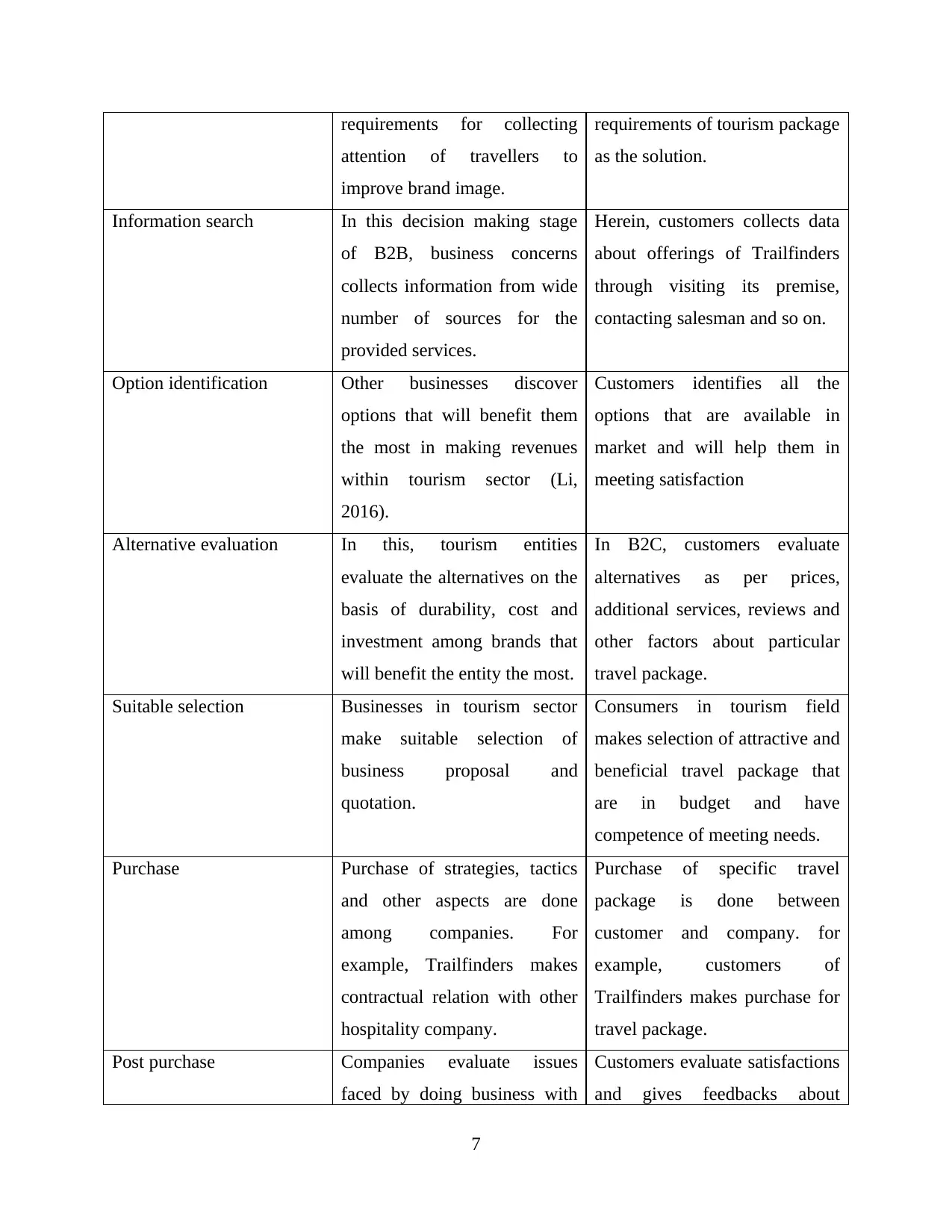
requirements for collecting
attention of travellers to
improve brand image.
requirements of tourism package
as the solution.
Information search In this decision making stage
of B2B, business concerns
collects information from wide
number of sources for the
provided services.
Herein, customers collects data
about offerings of Trailfinders
through visiting its premise,
contacting salesman and so on.
Option identification Other businesses discover
options that will benefit them
the most in making revenues
within tourism sector (Li,
2016).
Customers identifies all the
options that are available in
market and will help them in
meeting satisfaction
Alternative evaluation In this, tourism entities
evaluate the alternatives on the
basis of durability, cost and
investment among brands that
will benefit the entity the most.
In B2C, customers evaluate
alternatives as per prices,
additional services, reviews and
other factors about particular
travel package.
Suitable selection Businesses in tourism sector
make suitable selection of
business proposal and
quotation.
Consumers in tourism field
makes selection of attractive and
beneficial travel package that
are in budget and have
competence of meeting needs.
Purchase Purchase of strategies, tactics
and other aspects are done
among companies. For
example, Trailfinders makes
contractual relation with other
hospitality company.
Purchase of specific travel
package is done between
customer and company. for
example, customers of
Trailfinders makes purchase for
travel package.
Post purchase Companies evaluate issues
faced by doing business with
Customers evaluate satisfactions
and gives feedbacks about
7
attention of travellers to
improve brand image.
requirements of tourism package
as the solution.
Information search In this decision making stage
of B2B, business concerns
collects information from wide
number of sources for the
provided services.
Herein, customers collects data
about offerings of Trailfinders
through visiting its premise,
contacting salesman and so on.
Option identification Other businesses discover
options that will benefit them
the most in making revenues
within tourism sector (Li,
2016).
Customers identifies all the
options that are available in
market and will help them in
meeting satisfaction
Alternative evaluation In this, tourism entities
evaluate the alternatives on the
basis of durability, cost and
investment among brands that
will benefit the entity the most.
In B2C, customers evaluate
alternatives as per prices,
additional services, reviews and
other factors about particular
travel package.
Suitable selection Businesses in tourism sector
make suitable selection of
business proposal and
quotation.
Consumers in tourism field
makes selection of attractive and
beneficial travel package that
are in budget and have
competence of meeting needs.
Purchase Purchase of strategies, tactics
and other aspects are done
among companies. For
example, Trailfinders makes
contractual relation with other
hospitality company.
Purchase of specific travel
package is done between
customer and company. for
example, customers of
Trailfinders makes purchase for
travel package.
Post purchase Companies evaluate issues
faced by doing business with
Customers evaluate satisfactions
and gives feedbacks about
7
Paraphrase This Document
Need a fresh take? Get an instant paraphrase of this document with our AI Paraphraser
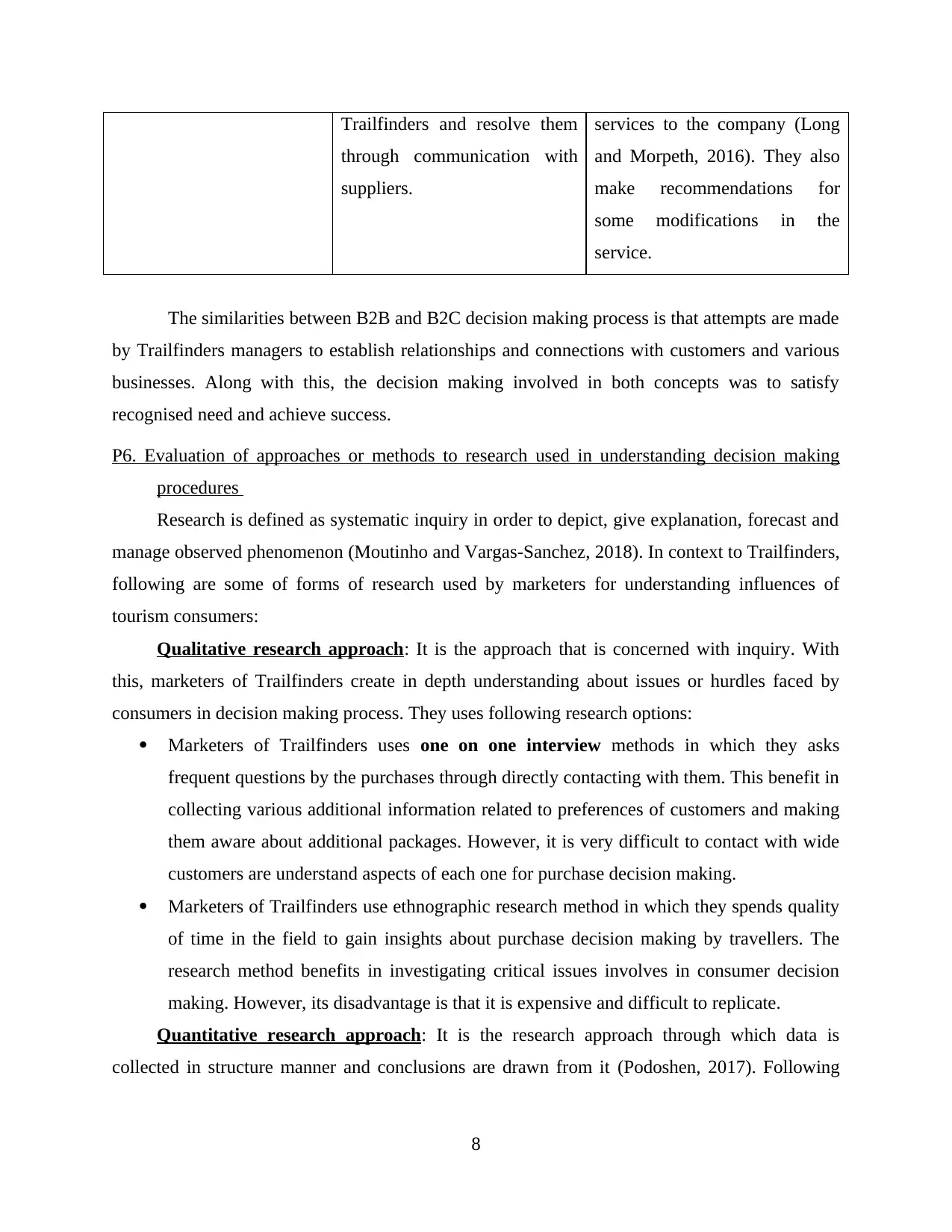
Trailfinders and resolve them
through communication with
suppliers.
services to the company (Long
and Morpeth, 2016). They also
make recommendations for
some modifications in the
service.
The similarities between B2B and B2C decision making process is that attempts are made
by Trailfinders managers to establish relationships and connections with customers and various
businesses. Along with this, the decision making involved in both concepts was to satisfy
recognised need and achieve success.
P6. Evaluation of approaches or methods to research used in understanding decision making
procedures
Research is defined as systematic inquiry in order to depict, give explanation, forecast and
manage observed phenomenon (Moutinho and Vargas-Sanchez, 2018). In context to Trailfinders,
following are some of forms of research used by marketers for understanding influences of
tourism consumers:
Qualitative research approach: It is the approach that is concerned with inquiry. With
this, marketers of Trailfinders create in depth understanding about issues or hurdles faced by
consumers in decision making process. They uses following research options:
Marketers of Trailfinders uses one on one interview methods in which they asks
frequent questions by the purchases through directly contacting with them. This benefit in
collecting various additional information related to preferences of customers and making
them aware about additional packages. However, it is very difficult to contact with wide
customers are understand aspects of each one for purchase decision making.
Marketers of Trailfinders use ethnographic research method in which they spends quality
of time in the field to gain insights about purchase decision making by travellers. The
research method benefits in investigating critical issues involves in consumer decision
making. However, its disadvantage is that it is expensive and difficult to replicate.
Quantitative research approach: It is the research approach through which data is
collected in structure manner and conclusions are drawn from it (Podoshen, 2017). Following
8
through communication with
suppliers.
services to the company (Long
and Morpeth, 2016). They also
make recommendations for
some modifications in the
service.
The similarities between B2B and B2C decision making process is that attempts are made
by Trailfinders managers to establish relationships and connections with customers and various
businesses. Along with this, the decision making involved in both concepts was to satisfy
recognised need and achieve success.
P6. Evaluation of approaches or methods to research used in understanding decision making
procedures
Research is defined as systematic inquiry in order to depict, give explanation, forecast and
manage observed phenomenon (Moutinho and Vargas-Sanchez, 2018). In context to Trailfinders,
following are some of forms of research used by marketers for understanding influences of
tourism consumers:
Qualitative research approach: It is the approach that is concerned with inquiry. With
this, marketers of Trailfinders create in depth understanding about issues or hurdles faced by
consumers in decision making process. They uses following research options:
Marketers of Trailfinders uses one on one interview methods in which they asks
frequent questions by the purchases through directly contacting with them. This benefit in
collecting various additional information related to preferences of customers and making
them aware about additional packages. However, it is very difficult to contact with wide
customers are understand aspects of each one for purchase decision making.
Marketers of Trailfinders use ethnographic research method in which they spends quality
of time in the field to gain insights about purchase decision making by travellers. The
research method benefits in investigating critical issues involves in consumer decision
making. However, its disadvantage is that it is expensive and difficult to replicate.
Quantitative research approach: It is the research approach through which data is
collected in structure manner and conclusions are drawn from it (Podoshen, 2017). Following
8
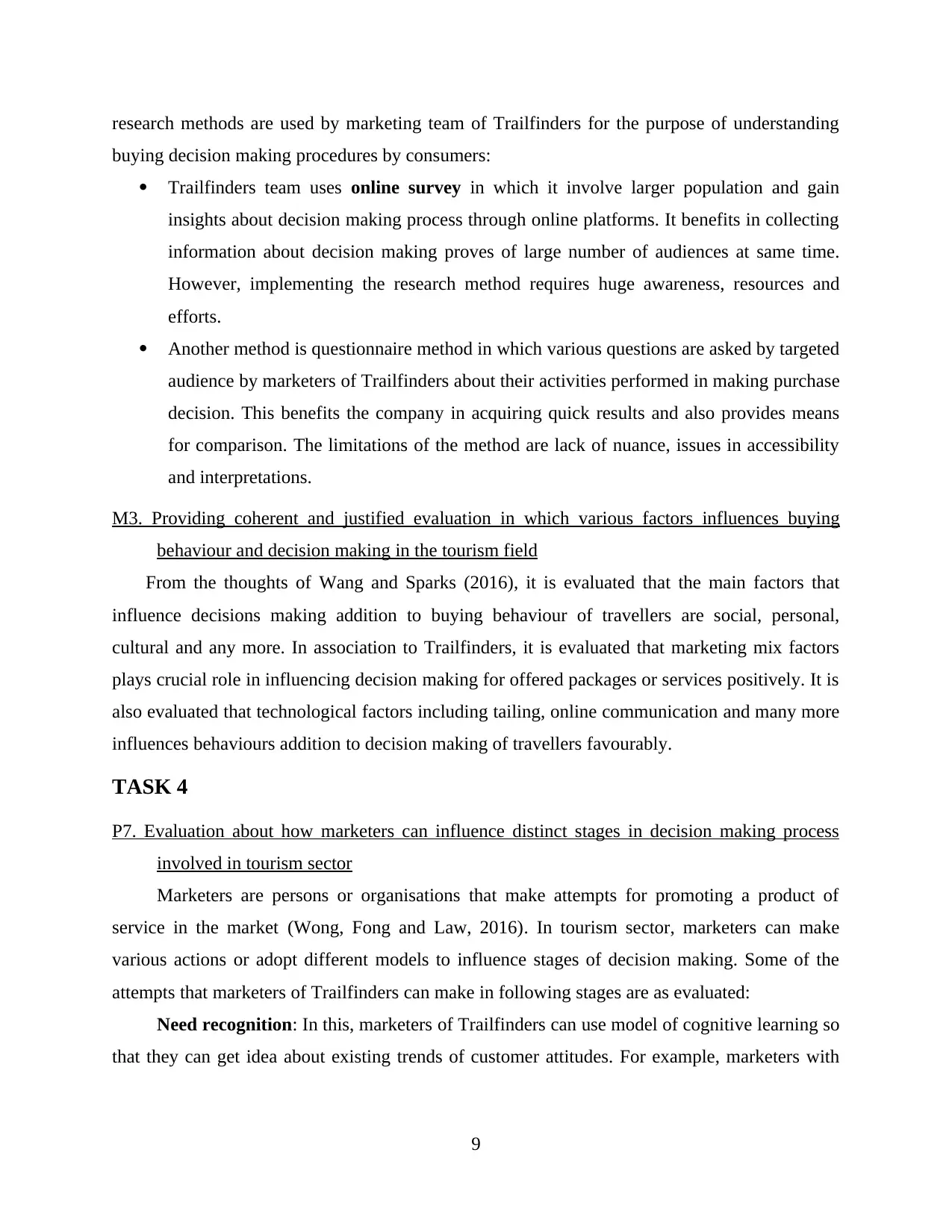
research methods are used by marketing team of Trailfinders for the purpose of understanding
buying decision making procedures by consumers:
Trailfinders team uses online survey in which it involve larger population and gain
insights about decision making process through online platforms. It benefits in collecting
information about decision making proves of large number of audiences at same time.
However, implementing the research method requires huge awareness, resources and
efforts.
Another method is questionnaire method in which various questions are asked by targeted
audience by marketers of Trailfinders about their activities performed in making purchase
decision. This benefits the company in acquiring quick results and also provides means
for comparison. The limitations of the method are lack of nuance, issues in accessibility
and interpretations.
M3. Providing coherent and justified evaluation in which various factors influences buying
behaviour and decision making in the tourism field
From the thoughts of Wang and Sparks (2016), it is evaluated that the main factors that
influence decisions making addition to buying behaviour of travellers are social, personal,
cultural and any more. In association to Trailfinders, it is evaluated that marketing mix factors
plays crucial role in influencing decision making for offered packages or services positively. It is
also evaluated that technological factors including tailing, online communication and many more
influences behaviours addition to decision making of travellers favourably.
TASK 4
P7. Evaluation about how marketers can influence distinct stages in decision making process
involved in tourism sector
Marketers are persons or organisations that make attempts for promoting a product of
service in the market (Wong, Fong and Law, 2016). In tourism sector, marketers can make
various actions or adopt different models to influence stages of decision making. Some of the
attempts that marketers of Trailfinders can make in following stages are as evaluated:
Need recognition: In this, marketers of Trailfinders can use model of cognitive learning so
that they can get idea about existing trends of customer attitudes. For example, marketers with
9
buying decision making procedures by consumers:
Trailfinders team uses online survey in which it involve larger population and gain
insights about decision making process through online platforms. It benefits in collecting
information about decision making proves of large number of audiences at same time.
However, implementing the research method requires huge awareness, resources and
efforts.
Another method is questionnaire method in which various questions are asked by targeted
audience by marketers of Trailfinders about their activities performed in making purchase
decision. This benefits the company in acquiring quick results and also provides means
for comparison. The limitations of the method are lack of nuance, issues in accessibility
and interpretations.
M3. Providing coherent and justified evaluation in which various factors influences buying
behaviour and decision making in the tourism field
From the thoughts of Wang and Sparks (2016), it is evaluated that the main factors that
influence decisions making addition to buying behaviour of travellers are social, personal,
cultural and any more. In association to Trailfinders, it is evaluated that marketing mix factors
plays crucial role in influencing decision making for offered packages or services positively. It is
also evaluated that technological factors including tailing, online communication and many more
influences behaviours addition to decision making of travellers favourably.
TASK 4
P7. Evaluation about how marketers can influence distinct stages in decision making process
involved in tourism sector
Marketers are persons or organisations that make attempts for promoting a product of
service in the market (Wong, Fong and Law, 2016). In tourism sector, marketers can make
various actions or adopt different models to influence stages of decision making. Some of the
attempts that marketers of Trailfinders can make in following stages are as evaluated:
Need recognition: In this, marketers of Trailfinders can use model of cognitive learning so
that they can get idea about existing trends of customer attitudes. For example, marketers with
9
⊘ This is a preview!⊘
Do you want full access?
Subscribe today to unlock all pages.

Trusted by 1+ million students worldwide
1 out of 15
Related Documents
Your All-in-One AI-Powered Toolkit for Academic Success.
+13062052269
info@desklib.com
Available 24*7 on WhatsApp / Email
![[object Object]](/_next/static/media/star-bottom.7253800d.svg)
Unlock your academic potential
Copyright © 2020–2025 A2Z Services. All Rights Reserved. Developed and managed by ZUCOL.





